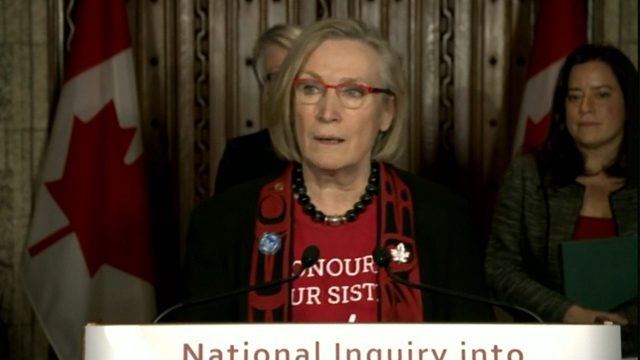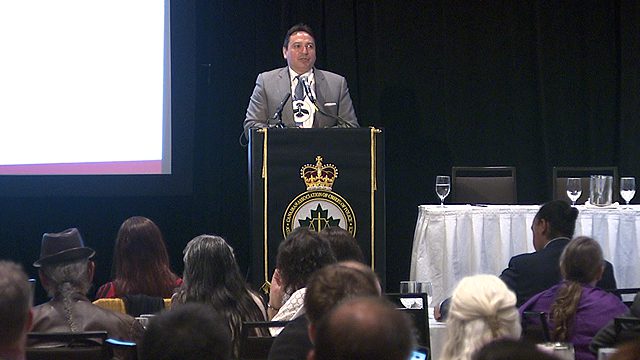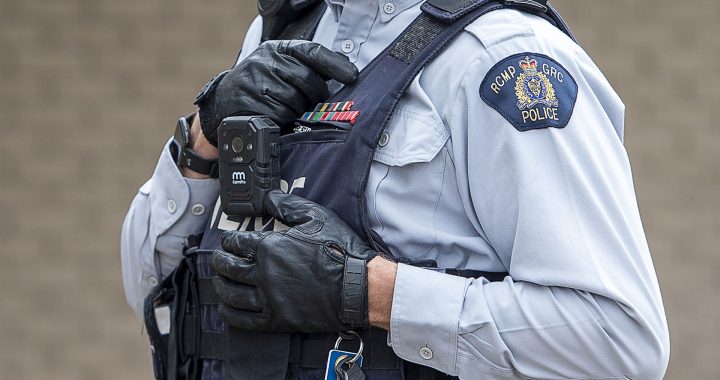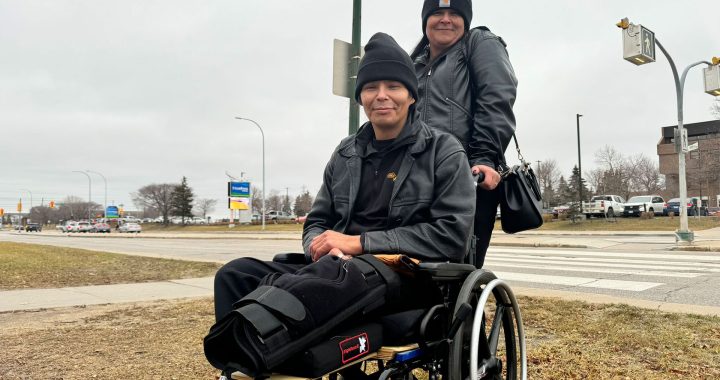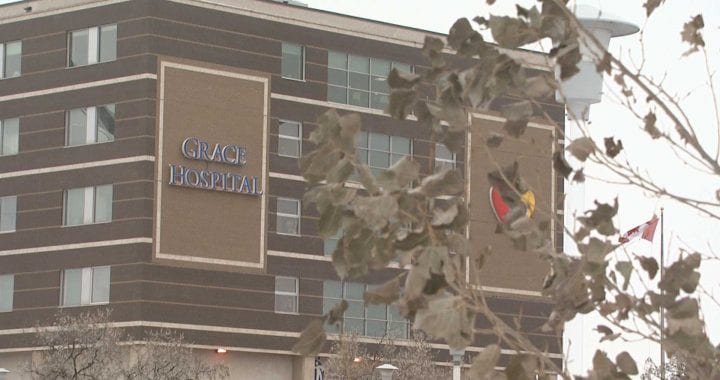APTN National News
The Minister of Indigenous Affairs is expected to announce the details of the long-awaited national inquiry into missing and murdered Indigenous women and girls Wednesday including the terms of reference and commissioners that will take the lead.
The inquiry was first announced by Carolyn Bennett and Status of Women Minister Patty Hadju back in December 2015. The government followed the announcement with 17 information sessions to hear from families across the country about what they wanted from the inquiry and how the terms of reference should be written. Part of what the government heard was:
Part of what the government heard was:
- The leadership should represent Indigenous communities and regions.
- It should also have a timetable that is sensitive to the needs of survivors, families and loved ones.
- Efforts must be made to avoid a long, drawn-out and legal process.
- The inquiry should include as many individuals and organizations as possible including survivors, families and loved ones, national Indigenous organizations, front-line workers, and Indigenous community leaders and organizations.
- It should also respect different points of view.
- The inquiry should take a broad approach to its analysis of the issues. It should look at the economic, cultural, political and social causes of violence against women, girls and trans and two-spirit people.
- It should also look at the causes of unequal and unjust treatment of Indigenous women, girls and trans and two-spirit people and recommend solutions to the causes of violence.
- The inquiry should provide a variety of cultural, spiritual and religious supports and ceremonies.
- The ceremonies should reflect the diversity of all participants and regions and be supported by elders.
- As well, it will be critical to have professional mental health counselling and community-based health supports. Professional and culturally-sensitive counselling will be needed if the inquiry is to be effective and avoid causing further trauma.
Police have been a focus of many families and groups who are looking to the inquiry to find answers.
In June, Assembly of First Nations National Chief addressed a conference of Canadian police forces telling those gathered that he was “putting them on notice” because families wanted answers on how investigators handled these cases.
Police services across the country have long been criticized for their handling of cases of missing and murdered Indigenous women and a number of families are awaiting news about how police forces will be scrutinized during the inquiry.
In July, APTN National News was the first to obtain a draft of the terms of reference that will guide five commissioners in their duties. While police are not mentioned specifically, the early draft seems to give the commissioners the leeway to examine any institution they believe needs to appear at the inquiry.
But what can a national inquiry accomplish? Are there limitations?
The Women’s Legal, Education, Action Fund is a coalition of advocacy groups including the Aboriginal Legal Services of Toronto that legal action to advance women’s issues.
According to Christa Big Canoe, the organisations involved are watching the process to put together the inquiry. and has prepared a FAQ on what an inquiry can and cannot do.
It is reproduced here.
#1: What is a national Commission of Inquiry?
National Commissions of Inquiry are federally established investigations into issues of national importance. Federal inquiries are established under terms set out in the Inquiries Act. This Act says that the federal Cabinet can establish an inquiry at any time.
- Cabinet also has the discretion to determine the inquiry’s subject and scope. The Act is broad and gives the federal government ample discretion, so there is a lot of room for flexibility and creativity in designing the inquiry process. This can help to ensure a future inquiry will be a meaningful and sensitive process that includes diverse stakeholders.
- However, this also means that early and thorough research and consultation is especially important, as this will help inform the inquiry’s design so that it can facilitate and support a fair, responsive, and effective process.
#2: How is it different from a Truth and Reconciliation Commission or a Royal Commission?
Inquiries can take several forms. Royal commissions are a type of public inquiry. They receive a special seal from the Queen, but otherwise are not different from other types of public inquiry.
- Truth and reconciliation commissions are generally created to address mass human rights violations in a country’s past, usually as a country is transitioning from autocratic to democratic rule.
- Canada’s recent Truth and Reconciliation Commission was unique because it was established as one part of the Indian Residential Schools Settlement Agreement, which was negotiated by residential school survivors, churches that operated the schools, and the federal government.
#3: How long do inquiries usually last from start to finish?
The length of an inquiry can be decided by the government or the Commissioners at the start of the inquiry process, and the Commission is expected to keep to its deadlines.
- Past inquiries have varied considerably in length. For example, the Canadian Panel on Violence Against Women lasted two years, the Manitoba Aboriginal Justice Inquiry took three years, and the Royal Commission on Aboriginal Peoples lasted five years.
#4: Who can establish an inquiry?
National Commissions of Inquiry are established by the federal Cabinet.
#5: What could inquiry proceedings look like?
The Commission has the power to determine the methods of an inquiry. Some Commission meetings and proceedings may be open to the general public and informal in nature. These could involve open houses, or opportunities to submit written comments.
- A Commission may also decide to have some proceedings that are adversarial (i.e. court-like) hearings with witnesses, cross-examination, and legal representation. This format is adopted when Commissioners feel the need to test the evidence of presenters to sort out an unclear or contested situation. These types of proceeding may require the involvement of lawyers.
- A commission may also hold closed hearings for highly delicate evidence, or the Commission may hold invitational symposia (i.e. meetings that are only open to those who are personally invited) or other meetings to hear the views of experts or certain key stakeholders. Again, the wide discretion of the Commission with regards to designing its own process is important to keep in mind. A Commission can use any combination of the above-mentioned types of process.
- It can also design new and unique types of proceeding.
#6: Who will be able to participate in these proceedings?
Participation in an inquiry may depend on the type or format of the proceedings.
- For open and informal proceedings, the Commission may encourage widespread public participation, usually by means of written comments submitted on paper or electronically, or by presenting to Commissioners in person.
- Adversarial hearings may require standing to participate. This means that people who want to participate in the hearing process will need to establish either: 1) how they are affected by the issues being addressed in the hearing, or 2) how their participation would further the public interest. In this situation, the Commission would have the discretion to determine how it will assess whether individual applicants should have standing.
- The Commission would also have the authority to determine who will be granted standing. In addition to granting standing to participate in this sort of proceeding, a Commission has power under the Inquiries Act to require the attendance of witnesses through subpoenas. While formal in nature, these adversarial 3 proceedings do have the potential to delve into contested or unclear proceedings do have the potential to delve into contested or unclear situations in search of a full picture of what has happened.
- A Commission may also restrict participation to certain groups or individuals, depending on the issue being considered. For example, closed hearings may only be open to people who are personally invited.
#7: How will members of the public know whether they can participate?
Once a Commission of Inquiry is established and has designed its process, there will likely be some form of public notice informing members of the public about upcoming opportunities to participate in the inquiry. Such notices should also specify the means by which members of the public and interested parties will be able to participate.
#8: Could funding be available to inquiry participants?
A key issue for any Commission of Inquiry, and for its potential participants, is whether funding will be available to those from whom the Commission wishes to hear (i.e. grants standing to). In the past, such funding has been available at some Commissions for those taking part in either the fact-finding part of the Inquiry or its policy deliberations. It is useful to explore the practices of past Commissions to see how this funding is determined, as each Commission can establish its own rules and practices. However, as the Missing Women Inquiry in B.C. has demonstrated, it is essential that the government which establishes the Inquiry provide it with enough funding to permit it to grant funding to participants who need it. Some experts have provided guidance for setting up future Commissions of Inquiry funding mechanisms.
#9: What languages can an inquiry be conducted in?
There are no specific provisions in the Inquiries Act concerning which language an inquiry must use in its proceedings. Most national Commissions of Inquiry in the past have generally been conducted in either English, French, or both, though some have also enabled people to participate in Indigenous languages.
#10: What support could be provided to participants in an inquiry including survivors and the families of missing and murdered Indigenous women and girls?
Given that a Commission has the discretion to hire any staff it may require, and because it has the power to design its own process, it could ensure that support is provided to survivors, families, and others.
#11: Can an inquiry integrate ceremony?
Yes. As a Commission has the discretion to create its own process, it has the authority to integrate ceremony.
#12: Who leads an inquiry? And how are they chosen?
The Inquiries Act requires the Cabinet to appoint the Commissioners who will lead an inquiry. The Act specifies that Cabinet has the discretion to appoint one or several Commissioners (s3).
- In the past, Commissioners have tended to be retired judges, Attorneys General, or academics.
- However, Commissioners may be any person or persons whom the Cabinet determines has qualifications to lead a particular inquiry, and appointing a retired judge does not in and of itself does ensure an inquiry’s independence.
- Examples of Commissioners who have been appointed for other inquiries include Justice Sidney Lindon who led the Ipperwash Inquiry, while the Royal Commission on Aboriginal Peoples was co-chaired by George Erasmus a former national chief of the Assembly of First Nations, and Justice René Dussault from the Québec Appeal Court, with Viola Robinson, former president of the Native Council of Canada; Mary Sillett, former president of the national Inuit women’s association Pauktuutit and of the Inuit Tapirisat Canada; Paul Chartrand, a Métis lawyer and head of the Department of Native Studies at the University of Manitoba; Justice Bertha Wilson, former justice of the Supreme Court of Canada; and Allan Blakeney, former premier of Saskatchewan.
#13: What powers do Commissioners have?
Commissioners have quite extensive investigative powers.
- They are able to summon any witnesses to give evidence in person or in writing, or provide documents requested by the Commission (s4 Inquiries Act).
- Commissioners’ power to enforce the attendance of witnesses and compel them to give evidence is equal to that of courts in civil cases (s5 Inquiries Act).
- Commissioners have the statutory authority to hire administrative, legal, research, and investigative staff as well as recognized experts to assist the Commission in its tasks.
- Commissioners also have the discretion to hire whoever else they deem necessary (s11 Inquiries Act). This can include interpreters and support workers.
#14: Where can an inquiry take place?
Commissions have the discretion to hold meetings in and visit different parts of the country.
#15: Can there be regional or provincial branches of an inquiry?
While some provinces have their own legislation allowing their governments to establish provincial Commissions of Inquiry, these inquiries would only be able to examine agencies and issues that fall under their provincial jurisdiction. Although, it is worth noting that Ontario’s Public Inquiries Act permits the province to partner with the federal government in a joint public inquiry (s4). This section would allow a future national Commission of Inquiry to address provincial agencies and issues in Ontario.
- The fact that a national Commission of Inquiry is federally established does not legally preclude provinces from engaging in the process. To date, all provinces have publicly expressed support for a national inquiry into violence against Indigenous women and girls. This may indicate some willingness by the provinces to collaborate and assist with a future national inquiry.
- Further, as a national body, a federally established Commission of Inquiry is in a perfect position to address issues of interprovincial coordination and cooperation as well as coordination (or lack thereof) between the provinces and the federal government. This is significant in the context of violence against Indigenous women because the failure to provide co-ordination between different jurisdictions of the State has been identified by the United Nations inquiry report on murders and disappearances as a violation of the rights of Indigenous women in Canada. (This issue was also identified by the Inter-American Commission on Human Rights in its 2015 report, a 2013 Human Rights Watch report, a 2011 report by the SisterWatch program with the Vancouver Police Services, and a 2010 report by the Federal Provincial Territorial Coordinating Committee of Senior Officials on Criminal Justice. For more information on this issue please see this past LSC report).
#16: What is the possible scope of an Inquiry?
When Cabinet establishes a public inquiry, it must also specify the inquiry’s terms of reference. These terms of reference delineate the scope of an inquiry.
- They generally specify: who the Commissioner(s) will be, the mandate or purpose of the inquiry, and the powers the Commission will have.
- These terms of reference can also set the duration of an inquiry and any other specifications or guidelines Cabinet may want to include. Former Supreme Court of Canada Chief Justice Brian Dickson engaged in a pre-inquiry process to determine the terms of reference for the Royal Commission on Aboriginal Peoples. This pre-inquiry process is a good mechanism for ensuring consultation that will assist a government with developing strong terms of reference.
- Public inquiries can investigate and study facts and statistics as well as policies and broader systemic issues. As will be discussed in the five sub-questions below, both facts and their broader historical, social, and legal contexts are equally important.
- An inquiry can be well-equipped to study these things in an effective and helpful way. Can an inquiry develop a clearer idea of the statistics of missing and murdered Indigenous women and girls? Yes. Data collection and analysis is often a critical part of public inquiries. All inquiries are required to examine what is known, identify gaps in knowledge, and attempt to fill these gaps.
- Gaining an understanding, and contributing to the public understanding, of an issue is an important cornerstone of any effective inquiry. Further, the databases and other resources prepared during a Commission’s activities can be a very useful public resource if independently maintained after the inquiry ends.
- An example of this can is the Krever Inquiry, which was established to examine the tainted blood supply in Canada. The inquiry’s work and data collection ultimately led to the establishment of the Canadian Blood Services, an independent agency that continues to administer the country’s national blood bank. As such, these resources produced during the inquiry process continue to be an important living document for the public.
- The independent collection, ongoing management, and public reporting of data is an especially important issue in the context of violence against Indigenous women and girls in Canada. Over the course of many years, collection, analysis, and public release of statistics and other data has been uneven and insufficient. This has deprived families, communities, Indigenous peoples’ organizations, and the public of an accurate, comprehensive, accessible, and up-to-date statistical picture of disappearances and murders.
- The Sisters in Spirit database of the Native Women’s Association of Canada, which was in the process of addressing these issues, was defunded by the federal government in 2010. The RCMP have not been transparent with their data on this issue.
- Several grassroots databases have been initiated across the country that would benefit from being better resourced, more coordinated, integrated, and standardized.
Can an inquiry examine the root causes of violence against Indigenous women and girls?
Yes. The majority of the literature on the subject of violence against Indigenous women and girls is unanimous about its historical, sociological, and legal root causes. The 2015 Inter-American Commission on Human Rights report on missing and murdered Indigenous women in British Columbia discussed the systemic and sociological factors responsible for the disproportionate violence faced by Indigenous women in the province. It explained that the disappearances and murders of Indigenous women in Canada are part of a broader pattern of violence and discrimination against these women throughout the country (p11). The report also noted systemic failures in policing, as well as the legacies of Canadian colonization and the persistence of discriminatory laws such as the Indian Act were responsible for the violence (p12).
The 2015 United Nations Committee on the Elimination of Discrimination Against Women (CEDAW) report confirmed the broad systemic causes for violence against Indigenous women in Canada. These included the social and economic marginalization of Indigenous women in Canada, failures by the police to promptly and thoroughly investigate instances of violence against Indigenous women, and the reluctance of the federal government to take immediate and effective state action (p3).
Can an inquiry examine government policies, laws, and practices?
Yes. A national Commission of Inquiry will be able to examine existing laws and policies, as well as the legacies of past laws and policies. A Commission will also have the authority to examine prevalent practices within government agencies that may not be explicitly required by law (and/or may be inconsistent with the law).
Can an inquiry examine RCMP policies and conduct?
Yes. A national Commission of Inquiry will be able to investigate and examine systemic issues within the RCMP that relate to violence against Indigenous women and girls, including RCMP policies and the conduct of RCMP officers.
Can an inquiry examine individual cases of missing and murdered Indigenous women and girls?
It is important for the future inquiry to ensure that all investigations of missing and murdered women are thorough and unbiased. It is also important to review cases in a way that highlights both positive practices where they exist, as well as system failings that need to be addressed. If this is consistent with the Commission of Inquiry’s terms of reference, it may be possible for it to examine individual cases.
However, given the high volume of implicated cases, individual case reviews for all past cases may not be feasible. More importantly, a public inquiry may not be the most helpful or advantageous way to review individual cases. Rather, an independent civilian investigation unit whose sole purpose and focus is to investigate individual cases may be appropriate. Such a unit could liaise with the Commission but its mandate could extend beyond the life of the Commission. Ultimately, it will be important to ensure that any inquiry or civilian investigation unit reviewing individual cases is independent from government and accountable.
#17: How can an inquiry ensure it does not merely duplicate what has been done already by other inquests and inquiries?
When setting the inquiry’s terms of reference and determining its scope and tasks, preliminary research and consultation will be required to determine where knowledge gaps exists and how the Commission may be able to fill these gaps. This preliminary research will also be helpful in identifying steps that governments can take right away, without waiting for the results of the inquiry. For a more detailed description and discussion of the findings of past inquiries and reports, as well as a discussion of areas that still require further research and study, please see past work by the Legal Strategy Coalition on Violence Against Indigenous Women.
#18: How is the independence of an inquiry ensured?
The independence of past Commissions of Inquiry has generally been protected by ensuring that they are established at arm’s length from government. Practically speaking, this would require the Commission to have control over its own budget, structure, and other administrative decisions. In addition, the Commissioners must be seen to be independent, that is, not subject to guidance or direction from government once its initial terms of reference have been provided. It is also important that the Commissioners should not have been part of any past government or agency whose conduct will be examined.
#19: Are there any mechanisms to ensure a Commission’s accountability in the process and outcome of an inquiry?
Yes. The more proceedings are made open and accessible to the public, the more accountable and transparent the Commission will be perceived to be.
- Encouraging public scrutiny and media access can also help to ensure accountability.
- It is worth noting that the ultimate findings of a public inquiry are judicially reviewable by the Federal Court. This means that an individual can apply to the Federal Court to review a Commission’s decisions if it is believed that the decisions included factual or legal errors, failed to follow established procedures, or failed to conform to the scope of the Commission’s mandate.
- Judicial review can help to ensure a Commission’s accountability.
#20: When the inquiry provides recommendations, is there a way to guarantee that these recommendations are implemented?
There is no statutory duty to implement the recommendations of a national Commission of Inquiry.
- However, it is possible to take measures to improve the likelihood of recommendations being implemented. For example, eight years after the release of the final report of the Manitoba Aboriginal Justice Inquiry, the Manitoba government established the Aboriginal Justice Implementation Commission.
- This Commission was tasked with reviewing the original inquiry recommendations, assessing the extent to which they were implemented, and ultimately directing how they could best be implemented more effectively. What is included in the Commission’s mandate regarding expected outcomes will matter, as will public attention to ensuring that the Commission’s work is orientated towards producing action and concrete measurable change.
—



